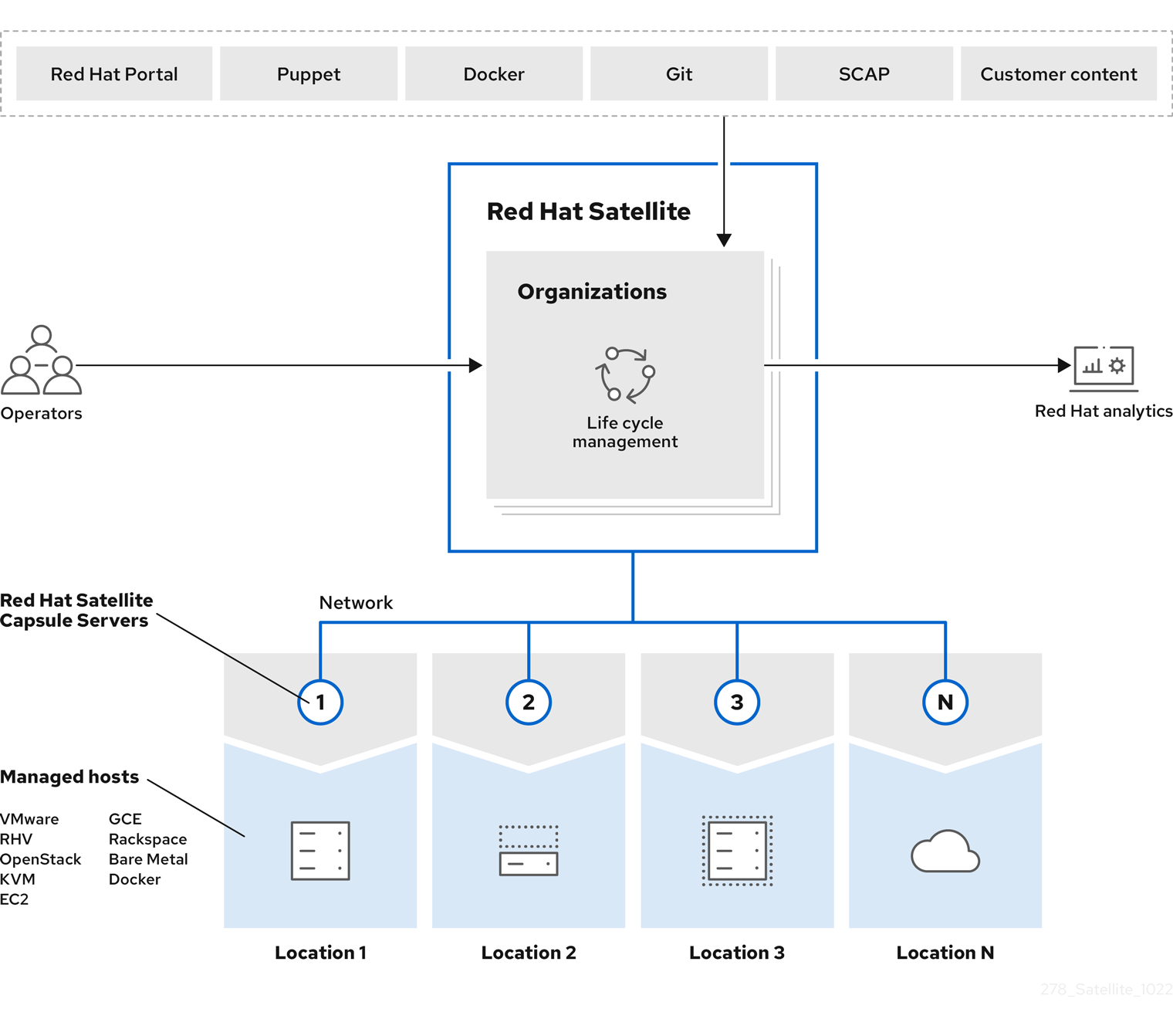Este conteúdo não está disponível no idioma selecionado.
Chapter 1. Content and patch management with Red Hat Satellite
With Red Hat Satellite, you can provide content and apply patches to hosts systematically in all lifecycle stages.
1.1. Content flow in Red Hat Satellite
Content flow in Red Hat Satellite involves management and distribution of content from external sources to hosts.
Content in Satellite flows from external content sources to Satellite Server. Capsule Servers mirror the content from Satellite Server to hosts.
- External content sources
- You can configure many content sources with Satellite. The supported content sources include the Red Hat Customer Portal, Git repositories, Ansible collections, Docker Hub, SCAP repositories, or internal data stores of your organization.
- Satellite Server
- On your Satellite Server, you plan and manage the content lifecycle.
- Capsule Servers
- By creating Capsule Servers, you can establish content sources in various locations based on your needs. For example, you can establish a content source for each geographical location or multiple content sources for a data center with separate networks.
- Hosts
- By assigning a host system to a Capsule Server or directly to your Satellite Server, you ensure the host receives the content they provide. Hosts can be physical or virtual.

Additional resources
- See Chapter 4, Major Satellite components for details.
- See Managing Red Hat subscriptions in Managing content for information about Content Delivery Network (CDN).
1.2. Content views in Red Hat Satellite
A content view is a deliberately curated subset of content that your hosts can access. By creating a content view, you can define the software versions used by a particular environment or Capsule Server.
Each content view creates a set of repositories across each environment. Your Satellite Server stores and manages these repositories. For example, you can create content views in the following ways:
- A content view with older package versions for a production environment and another content view with newer package versions for a Development environment.
- A content view with a package repository required by an operating system and another content view with a package repository required by an application.
- A composite content view for a modular approach to managing content views. For example, you can use one content view for content for managing an operating system and another content view for content for managing an application. By creating a composite content view that combines both content views, you create a new repository that merges the repositories from each of the content views. However, the repositories for the content views still exist and you can keep managing them separately as well.
Default Organization View
A Default Organization View is an application-controlled content view for all content that is synchronized to Satellite. You can register a host to the Library environment on Satellite to consume the Default Organization View without configuring content views and lifecycle environments.
Promoting a content view across environments
When you promote a content view from one environment to the next environment in the application lifecycle, Satellite updates the repository and publishes the packages.
Example 1.1. Promoting a package from Development to Testing
The repositories for Testing and Production contain the my-software-1.0-0.noarch.rpm package:
| Development | Testing | Production | |
|---|---|---|---|
| Version of the content view | Version 2 | Version 1 | Version 1 |
| Contents of the content view | my-software-1.1-0.noarch.rpm | my-software-1.0-0.noarch.rpm | my-software-1.0-0.noarch.rpm |
If you promote Version 2 of the content view from Development to Testing, the repository for Testing updates to contain the my-software-1.1-0.noarch.rpm package:
| Development | Testing | Production | |
|---|---|---|---|
| Version of the content view | Version 2 | Version 2 | Version 1 |
| Contents of the content view | my-software-1.1-0.noarch.rpm | my-software-1.1-0.noarch.rpm | my-software-1.0-0.noarch.rpm |
This ensures hosts are designated to a specific environment but receive updates when that environment uses a new version of the content view.
Additional resources
- For more information, see Managing content views in Managing content.
1.3. Content types in Red Hat Satellite
With Red Hat Satellite, you can import and manage many content types.
For example, Satellite supports the following content types:
- RPM packages
- Import RPM packages from repositories related to your Red Hat subscriptions. Satellite Server downloads the RPM packages from the Red Hat Content Delivery Network and stores them locally. You can use these repositories and their RPM packages in content views.
- Kickstart trees
- Import the Kickstart trees to provision a host. New systems access these Kickstart trees over a network to use as base content for their installation. Red Hat Satellite contains predefined Kickstart templates. You can also create your own Kickstart templates.
- ISO and KVM images
- Download and manage media for installation and provisioning. For example, Satellite downloads, stores, and manages ISO images and guest images for specific Red Hat Enterprise Linux and non-Red Hat operating systems.
- Custom file type
- Manage custom content for any type of file you require, such as SSL certificates, ISO images, and OVAL files.
1.4. Additional resources
- For information about how to manage content with Satellite, see Managing content.